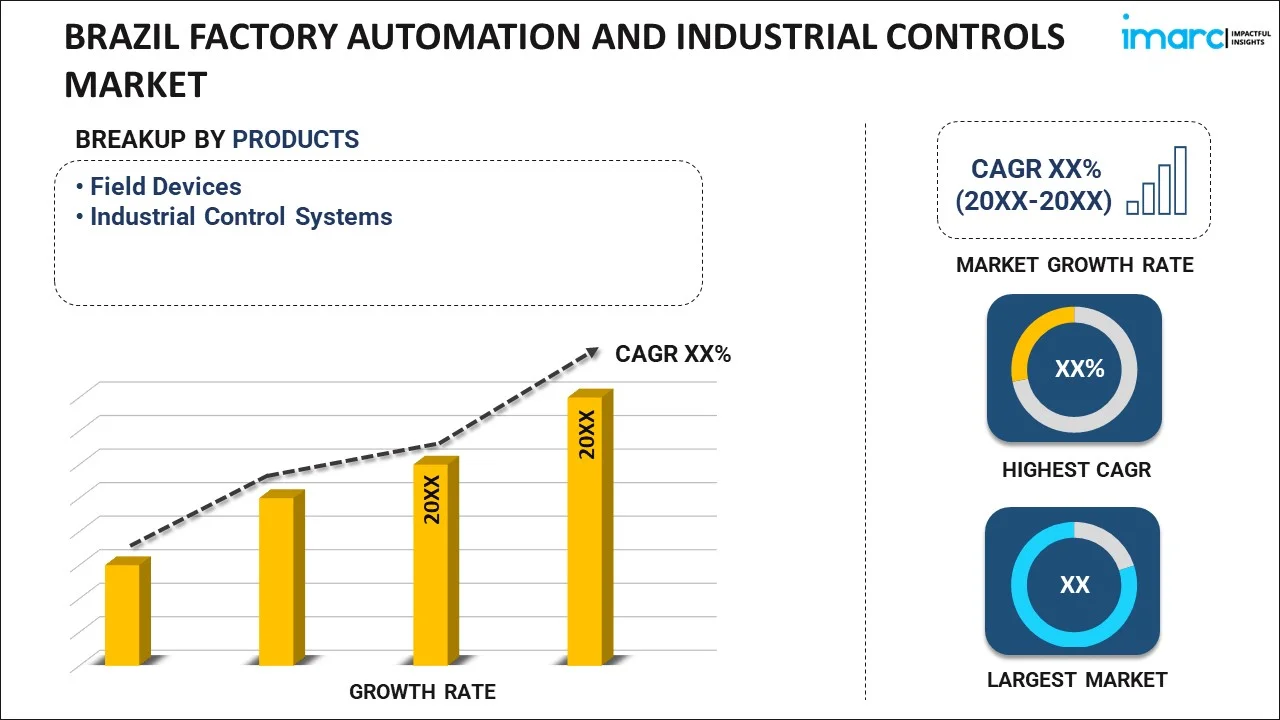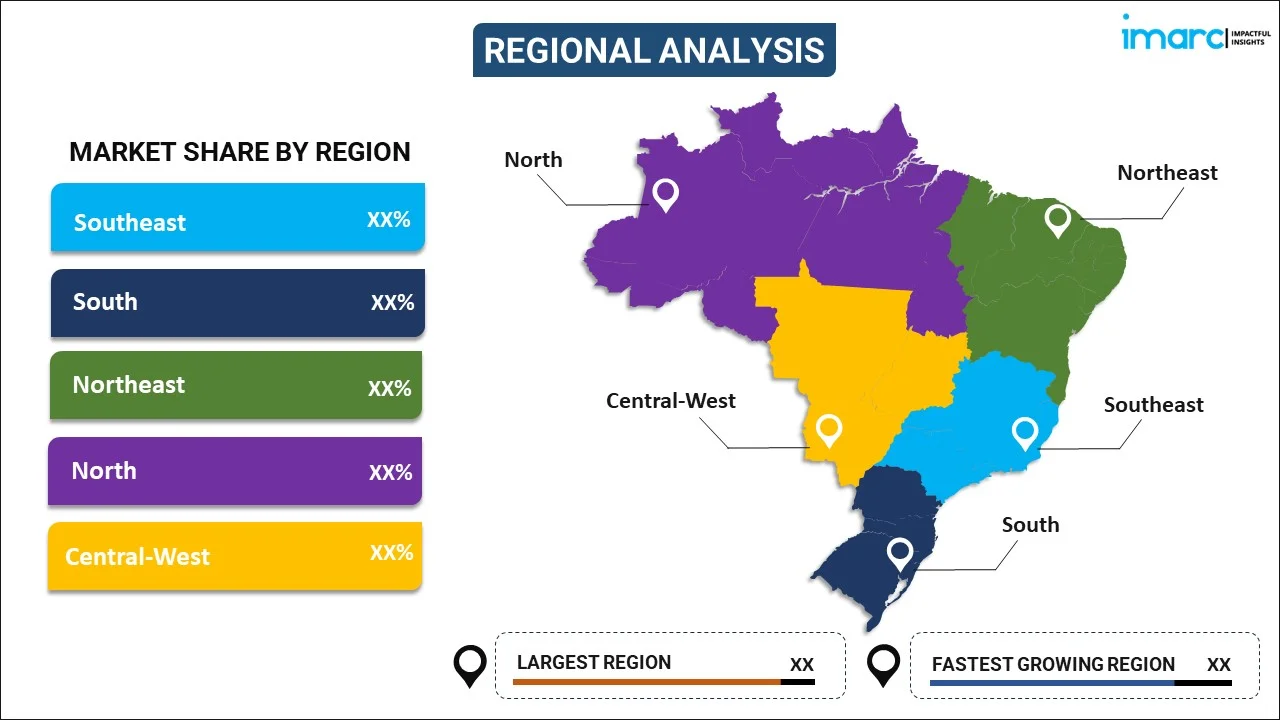
Brazil Factory Automation and Industrial Controls Market Report by Product (Field Devices, Industrial Control Systems), End Use Industry (Automotive, Chemical and Petrochemical, Power and Utilities, Pharmaceutical, Food and Beverage, Oil and Gas, and Others), and Region 2025-2033
Market Overview:
The Brazil factory automation and industrial controls market size reached USD 10.5 Billion in 2024. Looking forward, IMARC Group expects the market to reach USD 17.8 Billion by 2033, exhibiting a growth rate (CAGR) of 5.94% during 2025-2033. The rapid modernization in the manufacturing sector, the implementation of favorable government initiatives, growing focus on sustainable manufacturing practices, evolution of the Industrial Internet of Things (IIoT), and the increasing investment in advanced systems represent some of the key factors driving the market.
|
Report Attribute
|
Key Statistics
|
|---|---|
|
Base Year
|
2024 |
|
Forecast Years
|
2025-2033
|
|
Historical Years
|
2019-2024
|
| Market Size in 2024 | USD 10.5 Billion |
| Market Forecast in 2033 | USD 17.8 Billion |
| Market Growth Rate (2025-2033) | 5.94% |
Factory automation and industrial controls refer to systems and equipment designed to automate complex industrial tasks, thereby reducing the need for human intervention. They include simple control panels, programmable logic controllers (PLCs), distributed control systems (DCS), and manufacturing execution systems (MES). Factory automation and industrial controls utilize various microprocessors, sensors, actuators, and various types of software for smooth functioning. They find applications in a multitude of industries, including automotive, pharmaceuticals, food and beverage (F&B), oil and gas, textiles, and energy utilities. Factory automation and industrial controls offer numerous benefits, such as efficiency improvement, quality control, safety enhancements, and cost reduction. Moreover, they aid in increasing productivity, enhancing data analysis capabilities, improving resource management, reducing downtimes, and generating higher profitability.
Brazil Factory Automation and Industrial Controls Market Trends:
The rapid modernization in the manufacturing sector, creating opportunities for the adoption of advanced automation technologies, is one of the major factors contributing to the market growth. In line with this, the growing application of automation in industries like automotive, food and beverage (F&B), and pharmaceuticals to enhance efficiency and productivity is providing a thrust to the market growth. Moreover, the implementation of government initiatives aimed at modernizing infrastructure and promoting industrial development is creating a positive outlook for the market growth. In confluence with this, the introduction of supportive policies offering tax incentives for companies that invest in advanced manufacturing technologies is bolstering the market growth. Additionally, the growing focus on sustainable manufacturing practices, encouraging companies to adopt automation for energy efficiency and waste reduction, is propelling the market growth. Besides this, the evolution of the Industrial Internet of Things (IIoT), making it easier to implement sophisticated control systems that offer real-time insights and analytics, thereby improving decision-making processes, is providing a considerable boost to the market growth. Along with this, rapid advancements in collaborative robots, which are catalyzing the factory automation landscape across Brazil, are acting as a growth-inducing factor. In addition to this, the increasing investment in advanced systems by local manufacturers, owing to the rising pressure of global competition, is fueling the market growth. Apart from this, the prevalence of high labor costs, coupled with a growing need for precision and quality, making automation an attractive investment, is stimulating the market growth. Furthermore, the sudden shift towards digital twin technology, which involves creating a digital replica of physical systems for simulation, analysis, and control, is supporting the market growth. In line with this, the widespread adoption of artificial intelligence (AI) and machine learning (ML) algorithms into industrial control systems, facilitating smooth operations, are providing remunerative growth opportunities for the market.
Brazil Factory Automation and Industrial Controls Market Segmentation:
IMARC Group provides an analysis of the key trends in each segment of the market, along with forecasts at the country level for 2025-2033. Our report has categorized the market based on product and end use industry.
Product Insights:

- Field Devices
- Machine Vision
- Robotics
- Sensors
- Motors and Drives
- Relays and Switches
- Others
- Industrial Control Systems
- SCADA
- DCS
- PLC
- MES
- PLM
- ERP
- HMI
- Others
The report has provided a detailed breakup and analysis of the market based on the product. This includes field devices (machine vision, robotics, sensors, mortors and drives, relays and switches, and others) and industrial control systems (SCADA, DCS, PLC, MES, PLM, ERP, HMI, and others).
End Use Industry Insights:
- Automotive
- Chemical and Petrochemical
- Power and Utilities
- Pharmaceutical
- Food and Beverage
- Oil and Gas
- Others
A detailed breakup and analysis of the market based on the end use industry have also been provided in the report. This includes automotive, chemical and petrochemical, power and utilities, pharmaceutical, food and beverage, oil and gas, and others.
Regional Insights:

- Southeast
- South
- Northeast
- North
- Central-West
The report has also provided a comprehensive analysis of all the major regional markets, which include Southeast, South, Northeast, North, and Central-West.
Competitive Landscape:
The market research report has also provided a comprehensive analysis of the competitive landscape in the market. Competitive analysis such as market structure, key player positioning, top winning strategies, competitive dashboard, and company evaluation quadrant has been covered in the report. Also, detailed profiles of all major companies have been provided.
Brazil Factory Automation and Industrial Controls Market Report Coverage:
| Report Features | Details |
|---|---|
| Base Year of the Analysis | 2024 |
| Historical Period | 2019-2024 |
| Forecast Period | 2025-2033 |
| Units | Million USD |
| Scope of the Report | Exploration of Historical Trends and Market Outlook, Industry Catalysts and Challenges, Segment-Wise Historical and Future Market Assessment:
|
| Products Covered |
|
| End Use Industries Covered | Automotive, Chemical and Petrochemical, Power and Utilities, Pharmaceutical, Food and Beverage, Oil and Gas, Others |
| Regions Covered | Southeast, South, Northeast, North, Central-West |
| Customization Scope | 10% Free Customization |
| Post-Sale Analyst Support | 10-12 Weeks |
| Delivery Format | PDF and Excel through Email (We can also provide the editable version of the report in PPT/Word format on special request) |
Key Questions Answered in This Report:
- How has the Brazil factory automation and industrial controls market performed so far and how will it perform in the coming years?
- What has been the impact of COVID-18 on the Brazil factory automation and industrial controls market?
- What is the breakup of the Brazil factory automation and industrial controls market on the basis of product?
- What is the breakup of the Brazil factory automation and industrial controls market on the basis of end use industry?
- What are the various stages in the value chain of the Brazil factory automation and industrial controls market?
- What are the key driving factors and challenges in the Brazil factory automation and industrial controls?
- What is the structure of the Brazil factory automation and industrial controls market and who are the key players?
- What is the degree of competition in the Brazil factory automation and industrial controls market?
Key Benefits for Stakeholders:
- IMARC’s industry report offers a comprehensive quantitative analysis of various market segments, historical and current market trends, market forecasts, and dynamics of the Brazil factory automation and industrial controls market from 2019-2033.
- The research report provides the latest information on the market drivers, challenges, and opportunities in the Brazil factory automation and industrial controls market.
- Porter's five forces analysis assist stakeholders in assessing the impact of new entrants, competitive rivalry, supplier power, buyer power, and the threat of substitution. It helps stakeholders to analyze the level of competition within the Brazil factory automation and industrial controls industry and its attractiveness.
- Competitive landscape allows stakeholders to understand their competitive environment and provides an insight into the current positions of key players in the market.
Need more help?
- Speak to our experienced analysts for insights on the current market scenarios.
- Include additional segments and countries to customize the report as per your requirement.
- Gain an unparalleled competitive advantage in your domain by understanding how to utilize the report and positively impacting your operations and revenue.
- For further assistance, please connect with our analysts.
 Inquire Before Buying
Inquire Before Buying
 Speak to an Analyst
Speak to an Analyst
 Request Brochure
Request Brochure
 Request Customization
Request Customization




.webp)




.webp)












